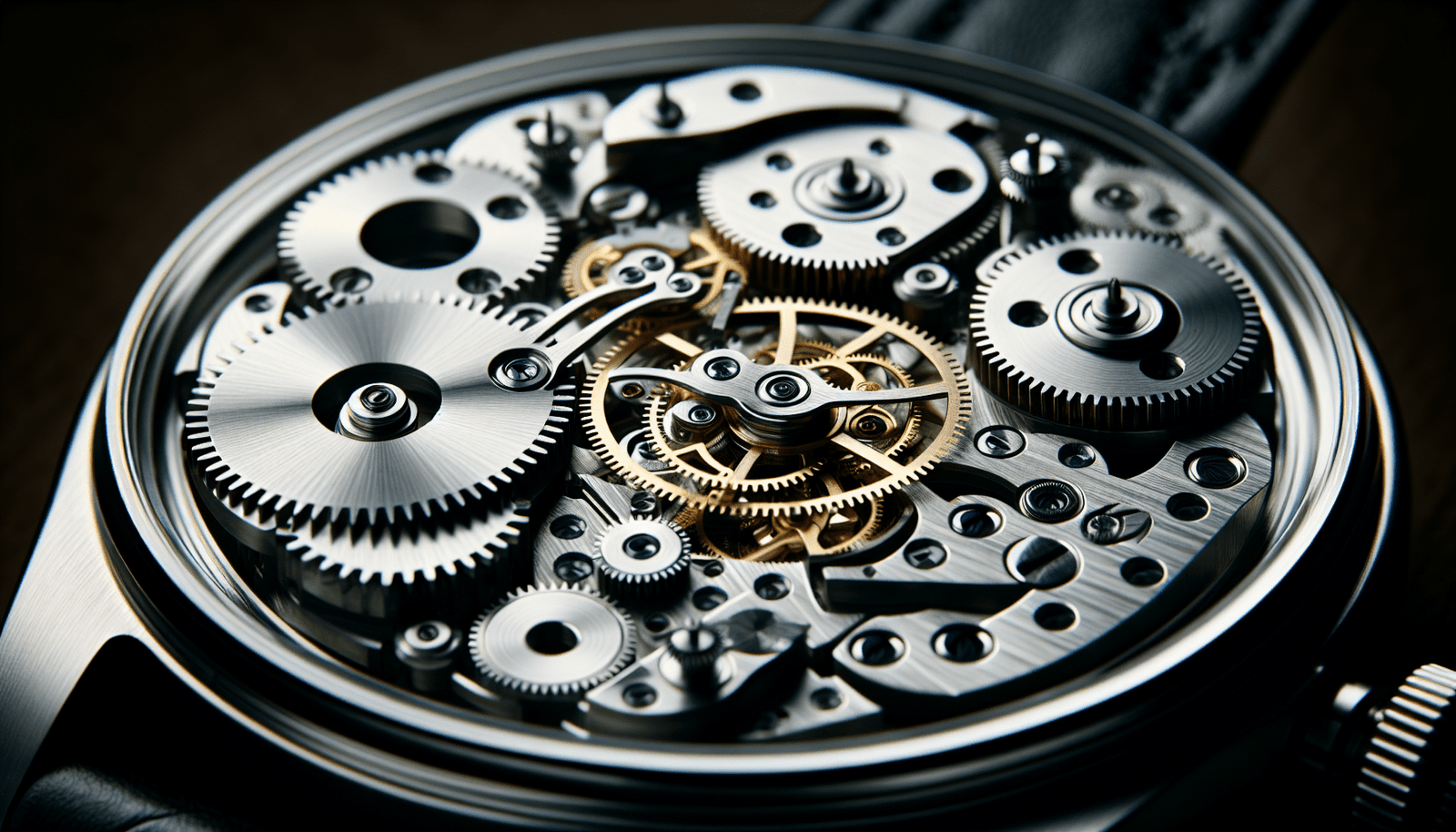
Have you ever wondered what sets luxury timepieces apart from their more affordable counterparts? One key factor lies in the concept of “in-house” movements. These movements, also known as calibers, are created entirely by the watch brand itself, from design to production. In this article, we will explore the significance of in-house movements in luxury watchmaking, shedding light on why they are highly valued by watch enthusiasts and collectors alike. Prepare to embark on a journey into the inner workings of the watchmaking world, where precision, craftsmanship, and exclusivity merge seamlessly.
Definition of In-house Movements
Explanation of in-house movements
In the world of luxury watchmaking, the term “in-house movements” refers to the internal mechanisms of a watch that have been designed, developed, and manufactured by the same company that produces the timepiece itself. These movements are often seen as a mark of prestige and quality, as they showcase the brand’s mastery of the intricate and complex art of horology. In-house movements are the heart and soul of a watch, responsible for keeping time accurately and ensuring the smooth functioning of its various complications.
What it means for a luxury watch
For a luxury watch, having an in-house movement is a symbol of excellence and craftsmanship. It signifies that the brand has invested extensive time, resources, and expertise into creating a timepiece that is truly unique and exceptional. In-house movements often incorporate advanced technologies, innovative features, and meticulous attention to detail, resulting in watches that not only possess impeccable accuracy but also exemplify the brand’s individuality and distinct style. Owning a luxury watch with an in-house movement is akin to owning a piece of mechanical art, crafted with passion and unwavering commitment to the highest standards of watchmaking.
History of In-house Movements
Early watchmaking practices
In the early days of watchmaking, which can be traced back to the 16th century, watchmakers would often rely on purchasing standardized movements, known as ébauches, from specialized suppliers. These ébauches provided the basic foundation of a watch, consisting of the main components such as the mainplate, bridges, gears, and barrels. Watchmakers would then assemble and finish these ébauches, adding their own unique touches and personalized features to create a timepiece that bore their name.
The emergence of in-house movements
As watchmaking evolved and technology advanced, some pioneering brands began to develop their own movements in-house. This shift allowed these brands to have complete control over the design, quality, and production of their timepieces, giving them a competitive edge in terms of innovation and exclusivity. The skill and expertise required to produce in-house movements meant that only a select few brands were capable of accomplishing this feat, further elevating their status within the world of luxury watches.

Advantages of In-house Movements
Control over quality and precision
One of the most significant advantages of in-house movements is the level of control it gives the brand over the quality and precision of their timepieces. By having complete control over every aspect of the movement’s design and production, watchmakers can ensure that the finished product meets their exacting standards. This includes the use of high-quality materials, precision engineering, and rigorous testing. The result is a watch that not only keeps time with utmost accuracy but also stands the test of time in terms of durability and reliability.
Ability to innovate
Having an in-house movement also enables brands to innovate and push the boundaries of watchmaking. By conducting extensive research and development, brands can introduce new technologies, materials, and complications into their movements, creating timepieces that are at the forefront of horological innovation. This ability to innovate not only sets brands apart from their competitors but also attracts discerning watch enthusiasts who seek exclusivity and uniqueness in their timepieces.
Exclusive designs and features
Perhaps the most coveted advantage of in-house movements is the opportunity for brands to create exclusive designs and features that are unique to their watches. With control over every aspect of the movement’s design, brands can unleash their creativity and artistic vision, resulting in timepieces that are visually stunning and aesthetically distinct. From intricate finishing and decoration techniques to proprietary complications, in-house movements allow brands to create watches that are truly one-of-a-kind, captivating the hearts of watch aficionados around the world.
Cost Considerations
Higher production costs
One of the drawbacks of developing in-house movements is the significant increase in production costs. Designing, researching, developing, and manufacturing a movement in-house requires substantial investments in terms of time, labor, and resources. Brands must employ highly skilled watchmakers, engineers, and technicians, as well as invest in state-of-the-art machinery and tools. All these factors contribute to the overall cost of producing a luxury watch with an in-house movement, making them more expensive than watches with sourced movements.
Potential for increased value
Despite the higher production costs, luxury watches with in-house movements often hold their value better than those with sourced movements. This is due to the perception of craftsmanship, exclusivity, and prestige associated with in-house movements. Watch enthusiasts and collectors place a premium on watches that are entirely conceived and manufactured by a single brand, as it represents a higher level of mastery and artistry. Consequently, these watches tend to have a higher resale value and can even appreciate over time, making them an investment for watch aficionados.

Brands Known for In-house Movements
Rolex
Rolex is renowned for its in-house movements, which are considered some of the most robust and reliable in the industry. From the iconic automatic caliber 3135 to the high-precision chronograph caliber 4130, Rolex movements are renowned for their accuracy and durability. Rolex’s commitment to in-house production ensures that every aspect of their movements is meticulously crafted and tested, making them a benchmark for quality in the luxury watch world.
Patek Philippe
Patek Philippe is widely regarded as one of the finest watchmakers in the world, known for their exceptional craftsmanship and innovation in watchmaking. Patek Philippe’s in-house movements, such as the ultra-thin self-winding caliber 240 and the hand-wound chronograph caliber 29-535, are meticulously crafted to achieve the brand’s stringent standards of precision and reliability. With a history dating back to 1839, Patek Philippe has established itself as a leader in the realm of in-house movements.
Audemars Piguet
Audemars Piguet is revered for its complex and intricately designed in-house movements, which are frequently regarded as works of art. The brand’s iconic ultra-thin caliber 2120, which was originally developed in collaboration with Jaeger-LeCoultre and Vacheron Constantin, showcases Audemars Piguet’s commitment to excellence and innovation. Audemars Piguet’s expertise in haute horlogerie is evident in their numerous in-house calibers, including the prestigious Royal Oak Offshore chronograph movement.
Omega
Omega, the distinguished Swiss watch brand, is celebrated for its precision and technological advancements in watchmaking. Omega’s in-house movements, such as the legendary caliber 321 used in the iconic Speedmaster Moonwatch and the Master Co-Axial series, exemplify the brand’s commitment to accuracy, reliability, and innovation. Omega’s in-house movements have played a significant role in the brand’s accomplishments, including their status as the official timekeepers of the Olympic Games.
Breitling
Breitling, known for its aviation-inspired timepieces, is another brand with a strong focus on in-house movements. Breitling’s in-house calibers, including the COSC-certified chronometer chronograph caliber B01 and the new manufacture caliber B20, showcase the brand’s technical prowess and dedication to precision. Breitling’s in-house movements form the backbone of their iconic collections, combining functionality and style in a way that appeals to professionals and watch enthusiasts alike.
In-house Movements vs. Outsourcing
Comparison with sourced movements
The contrast between in-house movements and sourced movements lies in the process and control over their production. In-house movements are developed entirely within the brand’s facilities, from conception to manufacturing, allowing for complete control over quality, design, and precision. On the other hand, sourced movements are purchased from specialized suppliers and are used by multiple brands with varying degrees of customization and finishing.
While sourced movements may offer cost and time efficiencies, in-house movements provide brands with the opportunity to differentiate themselves and establish their own unique identity. In-house movements are often seen as a mark of distinction and exclusivity, appealing to collectors and watch enthusiasts who value craftsmanship and individuality.
Controversies and debates
The debate between in-house movements and sourced movements has been a topic of contention within the watch industry. Some argue that in-house movements are merely a marketing tool, allowing brands to charge a premium without significant improvements in performance. Conversely, proponents of in-house movements highlight the expertise, craftsmanship, and innovation that come with creating movements in-house. Ultimately, the choice between in-house and sourced movements depends on a brand’s philosophy, resources, and desired positioning in the market.

Distinguishing Features of In-house Movements
Finishing and decoration
One of the distinguishing features of in-house movements is the level of finishing and decoration that brands apply to their movements. Craftsmen and artisans meticulously finish each component of the movement, adorning them with intricate designs, beveling edges, and applying various decorative techniques such as Côtes de Genève, perlage, and snailing. These finishing touches not only enhance the aesthetics of the movement but also serve as a testament to the brand’s commitment to craftsmanship and attention to detail.
Technical specifications
In-house movements often boast technical specifications and features that showcase the brand’s technical expertise and innovation. Brands may develop proprietary complications, such as tourbillons, perpetual calendars, or minute repeaters, to differentiate themselves from competitors and demonstrate their mastery of the art of watchmaking. These technical advancements can include improvements in accuracy, power reserve, shock resistance, and anti-magnetic properties, further enhancing the performance and functionality of the watch.
Examples of Notable In-house Movements
Rolex Caliber 3135
Rolex’s caliber 3135 is one of the most iconic and robust in-house movements in the industry. Known for its precision and reliability, the automatic movement powers several of Rolex’s most renowned models, including the Datejust, Submariner, and Sea-Dweller. The caliber 3135 boasts a 48-hour power reserve, self-winding mechanism, and the brand’s patented Parachrom hairspring, which enhances its resistance to temperature variations and shocks.
Patek Philippe Caliber 240
Patek Philippe’s caliber 240 is a testament to the brand’s commitment to ultra-thin movements and exceptional finishing. The self-winding caliber powers a range of Patek Philippe watches, including the iconic Calatrava collection. Notable features of the caliber 240 include a micro-rotor for efficient winding, a 48-hour power reserve, and a slim profile that allows for elegant and slim watch designs. The movement is made in-house and adheres to Patek Philippe’s stringent quality standards.
Audemars Piguet Caliber 3120
Audemars Piguet’s caliber 3120 exemplifies the brand’s technical expertise and dedication to producing high-performance movements. The self-winding movement, developed entirely in-house, powers several Audemars Piguet models, including the Royal Oak and Royal Oak Offshore collections. Noteworthy features of the caliber 3120 include a 60-hour power reserve, a bi-directional winding system, and an oscillating weight adorned with the brand’s distinctive logo. The movement is meticulously finished and reflects Audemars Piguet’s commitment to craftsmanship.
Future Trends in In-house Movements
Increased demand for exclusivity
As the luxury watch market evolves, there is a growing demand for exclusivity and uniqueness among consumers. This trend is likely to drive brands to invest even more in developing in-house movements that set them apart from their competitors. Customers are increasingly seeking watches that not only keep accurate time but also have a distinct identity and story to tell. In-house movements provide brands with the opportunity to create watches that are truly exceptional in terms of design, technical capabilities, and craftsmanship, catering to this growing demand for exclusivity.
Technological advancements
Advancements in technology are expected to play a significant role in the future of in-house movements. Watchmakers and engineers will continue to embrace innovative materials, manufacturing techniques, and mechanical solutions to enhance the performance, precision, and durability of their movements. Additionally, the integration of smartwatch features and connectivity may present new opportunities for the development of hybrid movements that seamlessly blend traditional mechanical watchmaking with modern technology.
Conclusion
The prominence of in-house movements in luxury watchmaking has continued to grow as brands recognize the value and significance they bring to their timepieces. In-house movements offer brands control over every aspect of their creations, from design and manufacturing to quality and performance. They allow for innovation, exclusivity, and the preservation of traditional watchmaking techniques. As watch enthusiasts demand timepieces that exemplify craftsmanship and individuality, the future of in-house movements remains vibrant and integral in the world of luxury watches.
For luxury watch enthusiasts, embracing the realm of in-house movements means owning a watch that embodies the dedication, expertise, and passion of the brand that created it. These timepieces are not only precision instruments but also symbols of artistry and excellence. As the demand for exclusivity and uniqueness continues to rise, in-house movements will remain at the forefront of luxury watchmaking, captivating collectors and connoisseurs with their unrivaled craftsmanship and timeless appeal.